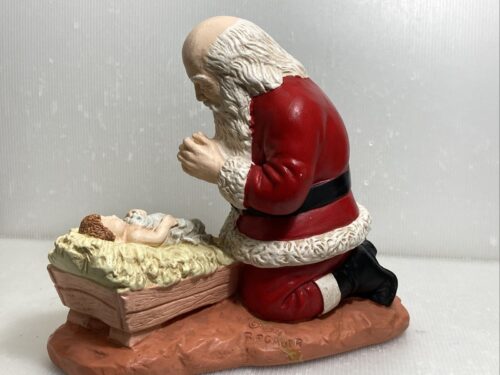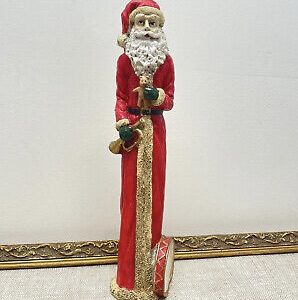In early December the Reverend Philip Croswell stood at the front window watching a light snow sift through the darkening day. At least, Alice assumed he was watching the snow, until he spoke.
Without turning to face her, he said, “I don’t like the looks of that man across the street. What is he doing there?”
Alice rose from the couch, joined her husband at the window, and followed his gaze.
He appeared to be staring fixedly at a life-size figure of Santa Claus that the neighbors had placed on their front lawn.
“Dear,” said Alice, “that’s Santa Claus. You know Santa.”
Phillip looked doubtful.
“Besides, honey, he isn’t real. He’s just a statue.”
Philip was plainly confused. And when Alice looked back at the figure, it did seem remarkably lifelike—one of those 1950’s Coke effigies bursting with bonhomie.
“Come, Philip, sit with me on the couch. Let’s color a picture.”
Alice led him to the couch, sat him down, and got his Christmas coloring book and crayons. But when she turned to a picture of Santa Claus, Philip recoiled. Quickly she found a picture of Rudolph, handed him the red crayon, and he relaxed.
The next day Philip stood again at the living room window at dusk, and again Alice was on the couch, doing her crossword.
“I don’t like him. What’s he doing there? I think he’s up to no good.”
Philip’s voice was tense, spectral. Rising, Alice put her arm around his waist, and saw that once again he was staring at the lighted figure of Santa.
“Honey, it’s only Santa Claus. Remember? It’s December.”
Philip regarded her blankly. He did not remember. A pastor for forty years, he was now deep in the dark vale of Alzheimer’s, where Santa, having lost his way on a foggy night, could not follow.
Supper, as usual, was on TV tables in the den, while they watched Philip’s shows. By eight o’clock he would be ready to be put to bed. But tonight, as luck would have it, a new ad was playing: a skit of Santa selling power tools, which apparently he used in the construction of the North Pole village.
Philip freaked out, upsetting the flimsy table and spilling lasagna and ginger ale everywhere.
“Who is he?” he demanded. “What’s he doing here?”
“Philip, dear, settle down. I’ll turn it off. There, you see? The nasty man is gone.”
It was after nine before Alice got him tucked into bed, but for an hour he lay staring wide-eyed at the ceiling, before finally drifting off.
Philip’s descent down unmemory lane had been a gentle one; he had not gone through an angry or agitated phase, and normally he slept peacefully. But this night he awoke thrashing and crying out, and Alice wondered if he were dreaming of the the man in the red suit. The next evening she herself, gazing with Philip at the mystery man across the way, saw the figure for a moment—just a moment—as the devil.
After that, she took to closing the curtains mid-afternoon, before the plastic Santa was turned on and glowed garishly. It pained her to do so, as she enjoyed the Christmas lights. But Philip’s peace came first, as that, more than anything, was what had made this whole ordeal bearable.
That evening, of course, they could not watch his shows, and had to settle for re-runs of Bonanza. And that night, once again his sleep was troubled. When this happened for a third night, Alice was beside herself. It was hard enough that he couldn’t find his way to the bathroom and always had to be helped, so that for over a year Alice had gotten very little sleep herself. But now, after three sleepless nights, she was at the breaking point.
How much longer could she keep this up? Was it even right to keep trying? A successful real estate agent before Philip’s illness, by nature she was no nurse. And Philip, though extraordinarily placid, required constant attention. Seldom would he sit quietly by himself, but wanted Alice always to be with him. It was draining, exhausting. She was worn down.
For some time Philip’s name had been on the list for a long-term care home. But what if a bed became available? What if the phone rang one day and Alice had to decide on the spot? Could she bear to send him away? And how would he react? But wasn’t Alice only human? Philip was so clingy, she could hardly even talk to her friends on the phone. Didn’t she have a right to some kind of life for herself? To be shut up with a helpless man who was afraid of Santa Claus—was it healthy? Was she going crazy too?
One day when Philip was at his support group—Alice’s one weekly break from him—a friend dropped in for tea and Alice made the mistake of telling her about the Santa problem.
“My boy Johnny used to be afraid of Santa,” said the friend, “but he got over it, and I’m sure your Philip will too.”
A week before Christmas, a bed opened up at Bethlehem House. On the phone Alice burst into tears. “Yes, oh yes! We’ll take it. Oh, thank you!”
But afterwards, how guilty she felt! After forty-five years of marriage, to ship one’s beloved off to an institution … What kind of person would do that? A person, she finally decided, who was on the verge of the screaming meemies.
Several times in the coming days Alice tried to break the news to Philip, but each time he became distressed. The day she drove him to the care home, with his things secretly packed, she was careful to distract him as she backed the car out and drove past the neighbor’s Santa.
“Where are we going?” he asked.
“Just a little drive to look at the Christmas decorations,” she lied. “You’ll like that, won’t you?”
All went well until they arrived at Bethlehem House, when wouldn’t you know it, there by the front door was a crèche scene, with a red-suited Santa kneeling by the crib. Again Alice tried to distract Philip’s attention, but it was too late. He had seen the offending figure and was gazing at it raptly.
She parked the car, and still he could not take his eyes from the crèche.
Finally he said, in a tone of wonder, “Alice, it’s that man.”
“Yes, Philip.”
“And he’s kneeling.”
“Yes.”
Instead of being upset, Philip seemed lost in some transport. Having expected a scene, Alice sighed with relief.
“That man,” said Philip, “he must really love Jesus!”
Alice broke into giggles. “Yes! Yes, honey, he does.”
She helped him from the car, and as they approached the entrance Philip had to stop for a minute before the crèche, marveling.
And then, as it happened, upon entering the foyer, there in 3D and living color was a real life Santa, looking as if he might be waiting for a taxi, or perhaps a sleigh.
Without hesitation Philip approached the stranger and thrust out his hand, which Santa accepted, and the two shook warmly.
“Hello, brother. I’m Philip.”
“And I’m Santa. Ho-ho-ho!”
At that, something seemed to awaken in Philip, a flash of memory—only to submerge again.
“Santa,” he reflected. “A nice name. I’m glad to know you, brother.”
On the way to his room, Alice tried to explain one last time that this would be Philip’s new home, and she thought he would be fine here.
“Yes,” he replied. “It’s a good place.”
Then, like an afterthought, swimming up from the past came the words, “And a little child shall lead them.”
Read more of Mike Mason’s Christmas stories in Twenty-One Candles: Stories for Christmas, available in both paperback and e-book.
Next Post: Brand New Things for a Happy New Year: A 30-Day Experiment






